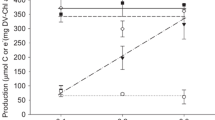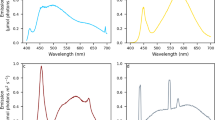Abstract
The marine chrysophyteMonochrysis lutheri was grown in phosphorus-limited continuous cultures at temperatures of 15°, 18.8° and 23°C. The effect of temperature on the maximum growth rate was well-defined by the Arrhenius equation, but the Q10 for this alga (1.7) was somewhat lower than has been determined previously for many other phytoplankton species (2.0–2.2). The minimum phosphorus cell quota was relatively unaffected by temperature at 18.8°C and 23°C, but doubled in magnitude at 15°C. As a result, the internal nutrient equation of Droop described the relationship between specific growth rate and phosphorus cell quota well at 18.8° and 23°C, but was less successful at 15°C. The major limitation in using the Droop equation is that the ratio between the minimum and maximum cell quotas must be known, thus necessitating the need to establish the true maximum growth rate by the cell washout technique. In addition, the phosphorus uptake rate on a cell basis at a given steady state growth rate (=specific uptake rate) increased dramatically at 15°C, whereas the turnover rate of total available phosphorus was unaffected by temperature. Both the nitrogen and carbon cell quotas were relatively unaffected by growth rate at a given temperature, but the average values increased slightly with decreasing temperature. The overall conclusion is that phytoplankton growth and limiting-nutrient uptake rates are only synchronous at or near the optimum temperature. Because these types of responses are species specific, much additional data on temperature effects will be required before the importance of including such effects in phytoplankton-nutrient models can be determined.
Similar content being viewed by others
References
Ahlgren, G.: Growth ofOscillatoria agardhii in chemostat culture. 2. Dependence of growth constants on temperature. Mitt. Internat. Verein. Limnol.21, 88–102 (1978)
Burmaster, D. M.: Steady and unsteady continuous culture ofMonochrysis lutheri under phosphate limitation. Ph.D. thesis, Massachusetts Institute of Technology, Cambridge, MA (1978)
Conway, H. L., P. J. Harrison, and C. O. Davis: Marine diatoms grown in chemostats under silicate or ammonium limitation. II. Transient response ofSkeletonema costatum to a single addition of the limiting nutrient. Mar. Biol.35, 187–199 (1976)
Droop, M. R.: Vitamin B12 and marine ecology. IV. The kinetics of uptake, growth and inhibition inMonochrysis lutheri. J. Mar. Biol. Assoc. U.K.48, 689–733 (1968)
Droop, M. R.: The nutrient status of algal cells in continuous culture. J. Mar. Biol. Assoc. U.K.54, 825–855 (1974)
Eppley, R. W.: Temperature and phytoplankton growth in the sea. Fish. Bull.70, 1063–1085 (1972)
Eppley, R. W., and E. H. Renger: Nitrogen assimilation of an oceanic diatom in nitrogen-limited continuous culture. J. Phycol.10, 15–23 (1974)
Fuhs, G. W.: Phosphorus content and rate of growth in the diatomsCyclotella nana andThalassiosira fluviatilis. J. Phycol.5, 312–321 (1969)
Fuhs, G. W., S. D. Demmerle, E. Canelli, and M. Chen: Characterization of phosphorus-limited plankton algae (with reflections on the limiting-nutrient concept). Am. Soc. Limnol. Oceanogr. Spec. Symp.1, 113–133 (1972)
Goldman, J. C.: Phytoplankton response to waste-water nutrient enrichment in continuous culture. J. Exp. Mar. Biol. Ecol.23, 31–43 (1976)
Goldman, J. C.: Temperature effects on phytoplankton growth in continuous culture. Limnol. Oceanogr.22, 932–936 (1977)
Goldman, J. C.: Biomass production in mass cultures of marine phytoplankton at varying temperatures. J. Exp. Mar. Biol. Ecol.27, 161–169 (1977)
Goldman, J. C.: Steady state growth of phytoplankton in continuous culture: comparison of internal and external nutrient equations. J. phycol.13, 251–258 (1977)
Goldman, J. C., and E. J. Carpenter: A kinetic approach to the effect of temperature on algal growth, Limnol. Oceanogr.19, 756–766 (1974)
Goldman, J. C., and J. J. McCarthy: Steady state growth and ammonium uptake of a fast-growing marine diatom. Limnol. Oceanogr.23, 695–703 (1978)
Goldman, J. C., and J. H. Ryther: Temperature-influenced species competition in mass cultures of marine phytoplankton. Biotechnol. Bioeng.18, 1125–1144 (1976)
Guillard, R. R. L., and J. H. Ryther: Studies of marine planktonic diatoms. I.Cyclotella nana Hustedt andDetonula confervacea (Cleve) Gran. Can. J. Microbiol.8, 229–239 (1962)
Herbert, D., R. Elsworth, and R. C. Telling: The continuous culture of bacteria; a theoretical and experimental study. J. Gen. Microbiol.14, 601–622 (1956)
Hunter, K., and A. H. Rose: Influence of growth temperature on the composition and physiology of micro-organisms. J. Appl. Chem. Biotechnol.22, 527–540 (1972)
Kuvshinnikov, V. D., M. Sobotka, I. G. Minkevich, and V. K. Eroshin: Dependence of cell yield and specific growth rate ofCandida biodinii on temperature during continuous cultivation. Folia Microbiol.22, 189–197 (1977)
McCarthy, J. J., and J. C. Goldman: Nitrogenous nutrition of marine phytoplankton in nutrient depleted waters. Science203, 670–672 (1979)
Malone, T. C.: Light-saturated photosynthesis by phytoplankton size fractions in the New York Bight, USA. Mar. Biol.42, 281–292 (1977)
Paasche, E.: Silicon and the ecology and marine plankton diatoms. I.Thalassiosira pseudonana (Cyclotella nana) grown in a chemostat with silicate as the limiting nutrient. Mar. Biol.19, 117–126 (1973)
Panikov, N., and S. J. Pirt: The effects of cooperativity and growth yield variation on the kinetics of nitrogen and phosphate limited growth ofChlorella in a chemostal culture. J. Gen. Microbiol.108, 295–303 (1978)
Perry, M. J.: Phosphate utilization by an oceanic diatom in phosphorus-limited chemostat culture and in oligotrophic waters of the central North Pacific. Limnol. Oceanogr.21, 88–107 (1976)
Rhee, G.-Y.: Phosphate uptake under nitrate limitation byScenedesmus sp. and its ecological implications. J. Phycol.10, 470–475 (1974)
Rhee, G.-Y.: Effects of N:P atomic ratios and nitrate limitation on algal growth, cell composition, and nitrate uptake. Limnol. Oceanogr.23, 10–25 (1978)
Sakshaug, E.: Limiting nutrients and maximum growth rates for diatoms in Narragansett Bay. J. Exp. Mar. Biol. Ecol.28, 109–123 (1977)
Shelef, G., W. J. Oswald, and C. C. Golueke: Assaying algal growth with respect to nitrate concentration by a continuous flow turbiodostat. In S. H. Jenkins (ed.): Proc. Int. Conf. Water Pollut. Res., 5th ed., p. 3–25/1–9. Pergamon Press, London, (1971)
Swift, D. G., and W. R. Taylor: Growth of vitamin B12-limited cultures:Thalassiosira pseudonana, Monochrysis lutheri, andIsochrysis galbana. J. Phycol.10, 385–391 (1974)
Thomas W. H., and A. N. Dodson: Effect of interactions between temperature and nitrate supply on the cell-division rates of two marine phytoflagellates. Mar. Biol.24, 213–217 (1974)
Tilman, D., and S. S. Kilham: Phosphate and silicate growth and uptake kinetics of the diatomsAsterionella formosa andCyclotella menegheniana in batch and semicontinuous culture. J. Phycol.12, 375–383 (1976)
Wilkinson, G. N.: Statistical estimations in enzyme kinetics. Biochem, J.80, 324–332 (1961)
Williams, F. M.: Dynamics of microbial populations. In B. C. Patten (ed.): Systems Analysis and Simulation in Ecology, Vol. I, pp. 147–267. Academic Press, New York, (1971)
Author information
Authors and Affiliations
Rights and permissions
About this article
Cite this article
Goldman, J.C. Temperature effects on steady-state growth, phosphorus uptake, and the chemical composition of a marine phytoplankter. Microb Ecol 5, 153–166 (1979). https://doi.org/10.1007/BF02013523
Issue Date:
DOI: https://doi.org/10.1007/BF02013523




